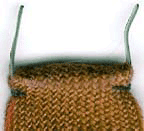|
In the first
BSA Handbook for Boys, patrol names were suggested along with
patrol colors. Each patrol was identified by a different set
of colors that were assigned to the name of the patrol. At least
some of these color assignments were incorporated into patrol
ribbons that the boys could make themselves or order from National
Supply. BSA used patrol ribbons for at least its first eighteen
years. From 1911-1916 they were 5 1/2" long. From 1917 to
1925 they were 5" and 4 1/2" from 1926 until at least
1929.
The original
British ribbons were strands of yarn and later, cloth ribbons.
BSA ribbons differed from those of other countries by the use
of a metal strip with prongs that could be pushed into the uniform
sleeve and folded over. While the first medallions (red felt
squares) were introduced in 1926, the ribbons were still authorized
as late as 1929 when the first Patrol Leader Handbook was published.
The 1929 PL handbook noted that a patrol could choose either
patrol ribbons or medallions and boys could either make them
themselves or order them from National Supply. The same patrol
leader handbook contained an advertisement for the first embroidered
medallions indicating that the ribbons were perhaps in use somewhat
later than the original screened medallions.
|

Example of BSA patrol ribbon
clasp showing tack-downs at each corner.
|